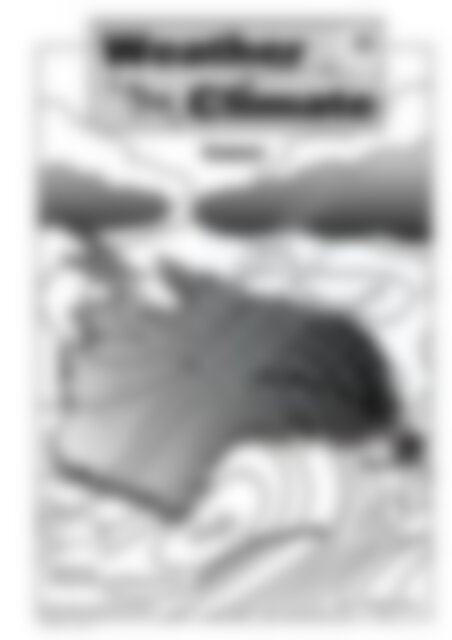RIC-0513 Weather and Climate Lower
Create successful ePaper yourself
Turn your PDF publications into a flip-book with our unique Google optimized e-Paper software.
a n d<br />
lower<br />
zzzz ,,,,, yyyyy<br />
zzzz |||| ,,,,, yyyyy {{{{{<br />
,,,,, yyyyy zzzz |||| {{{{{<br />
,,,,, yyyyy {{{{{ |||| zzzz<br />
Low<br />
©R.I.C. Publications<br />
Low Resolution Images<br />
Display Copy<br />
High<br />
Written by<br />
Roslyn Kay <strong>and</strong> Wendy Harris<br />
http://www.ricgroup.com.au<br />
R.I.C. Publications<br />
<strong>RIC</strong>-<strong>0513</strong> 3.7/327
H<br />
<strong>Weather</strong> <strong>and</strong> <strong>Climate</strong> - <strong>Lower</strong> Primary<br />
Foreword<br />
Written by Roslyn Kay <strong>and</strong> Wendy Harris<br />
<strong>Weather</strong> affects us in all aspects of our life. It is important to have a good underst<strong>and</strong>ing of the different<br />
elements of weather <strong>and</strong> how they affect our environment. This package provides a variety of activities that<br />
investigate weather in a creative <strong>and</strong> enjoyable manner. The contents link in well to a variety of curriculum<br />
areas including science, social studies <strong>and</strong> mathematics.<br />
A glossary is included to assist with the development of relevant language. Words found throughout the<br />
activities in bold text can be located in the glossary.<br />
Glossary .......................................................... ii<br />
What is <strong>Weather</strong> ...............................................1<br />
<strong>Weather</strong> Mobile ................................................2<br />
Today's <strong>Weather</strong> ..............................................3<br />
The <strong>Weather</strong> this Week ....................................4<br />
What is <strong>Climate</strong>?...............................................5<br />
The Sky ..............................................................6<br />
Water Cycle ......................................................7<br />
Rain ...................................................................8<br />
What is a Cloud? ..............................................9<br />
Wet <strong>and</strong> Dry .................................................... 10<br />
Water............................................................... 11<br />
Hail <strong>and</strong> Snow ................................................ 12<br />
Thunderstorms................................................ 13<br />
Thunder <strong>and</strong> Lightning .................................. 14<br />
Colour the Rainbow ....................................... 15<br />
Air <strong>and</strong> Wind .................................................. 16<br />
Air <strong>and</strong> Wind (2).............................................. 17<br />
Contents<br />
The Birth of a New Season ............................. 18<br />
Summer .......................................................... 19<br />
Autumn ........................................................... 20<br />
Winter .............................................................. 21<br />
Spring .............................................................. 22<br />
Warm in Winter –␣ Cool in Summer ............... 23<br />
Animals from Hot <strong>and</strong> Cold Countries .......... 24<br />
Yearly <strong>Weather</strong> Calendar ............................. 25<br />
Meteorologists ................................................. 26<br />
Australia's under the <strong>Weather</strong>....................... 27<br />
Measuring the <strong>Weather</strong> ................................. 28<br />
Make a <strong>Weather</strong>vane <strong>and</strong> Rain Gauge ....... 29<br />
Make a Snowflake .......................................... 30<br />
A Wet One - Poem .......................................... 31<br />
One Dark, Stormy Night ................................. 32<br />
<strong>Weather</strong> Word Sleuth .................................... 33<br />
Testing the <strong>Weather</strong> ....................................... 34<br />
©R.I.C. Publications<br />
Low Resolution Images<br />
Display Copy<br />
R.I.C. Publications<br />
<strong>Weather</strong> <strong>and</strong> <strong>Climate</strong><br />
i<br />
<strong>Lower</strong><br />
www.ricgroup.com.au
H<br />
Glossary<br />
Air<br />
Air pressure<br />
Air temperature<br />
Atmosphere<br />
Barometer<br />
<strong>Climate</strong><br />
Clouds<br />
Deciduous<br />
Drought<br />
Evaporation<br />
Forecast<br />
Flood<br />
Hail<br />
Hibernate<br />
Each word in the glossary has been set in bold print throughout the package.<br />
Lightning<br />
Maximum temperature<br />
Minimum temperatre<br />
Meteorologist<br />
Rain<br />
Rain gauge<br />
Reservoir<br />
Satellite<br />
Seasons<br />
Snow<br />
Space<br />
Thermometer<br />
Thunder<br />
Water vapour<br />
<strong>Weather</strong><br />
<strong>Weather</strong>vane<br />
Wind<br />
Gases that surround the earth.<br />
The weight of the air pressing down on the earth.<br />
The amount of heat in the air.<br />
Air around the earth.<br />
An instrument for measuring air pressure.<br />
Seasonal weather or yearly weather.<br />
Water drops that form in the air.<br />
Trees that lose their leaves.<br />
A severe shortage of water.<br />
Heated water that disappears into the air.<br />
To predict the weather.<br />
When too much rain falls.<br />
Small pellets of ice that fall like rain.<br />
Sleep in winter.<br />
An electric spark in the sky.<br />
The highest or hottest temperature.<br />
The lowest or coldest temperature.<br />
A person who studies the weather <strong>and</strong> atmosphere.<br />
Droplets of water that fall from the sky.<br />
Measures the amount of rain that falls.<br />
A place where water is stored.<br />
Human-made 'spaceship' that circles the earth.<br />
Four weather divisions of the year being summer,<br />
autumn, winter <strong>and</strong> spring.<br />
Ice crystals that fall from the sky.<br />
The sky above the atmosphere.<br />
Measures the heat in the air.<br />
The noise that occurs with lightning.<br />
The gas from heated water.<br />
The daily conditions in the atmosphere.<br />
An instrument that shows the direction of the wind.<br />
The flow of air over the earth.<br />
©R.I.C. Publications<br />
Low Resolution Images<br />
Display Copy<br />
R.I.C. Publications<br />
<strong>Weather</strong> <strong>and</strong> <strong>Climate</strong><br />
ii<br />
<strong>Lower</strong><br />
www.ricgroup.com.au<br />
ISBN 978-1-86311-324-3
H<br />
What is <strong>Weather</strong>?<br />
Each year the Earth follows a pattern of<br />
S E A S O N S <strong>and</strong> C L I M A T E.<br />
There are many signs of weather; for example:<br />
CLOUDS<br />
Three things make the signs of weather:<br />
AIR<br />
WIND<br />
WATER<br />
RAIN<br />
Place these words in the correct space below.<br />
1. gives us energy, light <strong>and</strong> heat.<br />
LIGHTNING<br />
2. makes a layer around the earth.<br />
3. is found in oceans, lakes, rivers <strong>and</strong><br />
puddles.<br />
What are some other uses of air, water <strong>and</strong> sun, for example;<br />
pumping up a tyre, having a shower, drying the washing.<br />
SUN<br />
©R.I.C. Publications<br />
Low Resolution Images<br />
Display Copy<br />
R.I.C. Publications<br />
<strong>Weather</strong> <strong>and</strong> <strong>Climate</strong><br />
1<br />
<strong>Lower</strong><br />
www.ricgroup.com.au<br />
ISBN 978-1-86311-324-3
H<br />
<strong>Weather</strong> Mobile<br />
Make a weather mobile showing the three weather signs.<br />
You will need a wire coat hanger.<br />
W E A T H E R<br />
WEATHER<br />
Water<br />
R.I.C. Publications<br />
<strong>Weather</strong> <strong>and</strong> <strong>Climate</strong><br />
2<br />
Sun<br />
©R.I.C. Publications<br />
Low Resolution Images<br />
Display Copy<br />
ISBN 978-1-86311-324-3<br />
Air<br />
<strong>Lower</strong><br />
www.ricgroup.com.au
H<br />
Today's <strong>Weather</strong><br />
Today is .<br />
Colour in the weather for today.<br />
HOT COLD RAINING CLOUDY<br />
©R.I.C. Publications<br />
Low Resolution Images<br />
Display Copy<br />
WINDY STORMS SNOWY<br />
HAIL<br />
Yesterday the minimum (coldest) temperature was .<br />
Yesterday the maximum (hottest) temperature was .<br />
R.I.C. Publications<br />
<strong>Weather</strong> <strong>and</strong> <strong>Climate</strong><br />
3<br />
<strong>Lower</strong><br />
www.ricgroup.com.au<br />
ISBN 978-1-86311-324-3
H<br />
The <strong>Weather</strong> this Week<br />
Week<br />
Name<br />
Find out how cold <strong>and</strong> how hot it got each day of the week. Put<br />
a tick if it was sunny, cloudy, windy, or if it rained.<br />
MONDAY<br />
TUESDAY<br />
WEDNESDAY<br />
THURSDAY<br />
FRIDAY<br />
SATURDAY<br />
SUNDAY<br />
Minimum<br />
(coldest)<br />
temperature<br />
Maximum<br />
(hottest)<br />
temperature<br />
RAIN WIND CLOUD SUN<br />
©R.I.C. Publications<br />
Low Resolution Images<br />
Display Copy<br />
For how many days of the week did it rain?<br />
For how many days of the week did the sun shine?<br />
Which day was the coldest?<br />
Which day was the hottest?<br />
R.I.C. Publications<br />
<strong>Weather</strong> <strong>and</strong> <strong>Climate</strong><br />
4<br />
<strong>Lower</strong><br />
www.ricgroup.com.au<br />
ISBN 978-1-86311-324-3
H<br />
What is <strong>Climate</strong>?<br />
The weather varies according to where you live. This weather<br />
makes your climate. Different parts of the world have different<br />
climate. The weather in each part of the world is important to the<br />
people, plants <strong>and</strong> animals that live there. Cut out <strong>and</strong> glue one<br />
plant <strong>and</strong> one animal from below onto the right climate section<br />
of the earth.<br />
Plants<br />
The World's <strong>Climate</strong> Zones<br />
North Pole<br />
Animals<br />
Very cold<br />
Warm<br />
Hot<br />
Warm<br />
Very cold<br />
©R.I.C. Publications<br />
Low Resolution Images<br />
Display Copy<br />
South Pole<br />
No plants<br />
No plants<br />
Kangaroo Elephant Seal<br />
Pine tree<br />
Pineapple<br />
Penguin<br />
Bison<br />
Gum tree<br />
R.I.C. Publications<br />
<strong>Weather</strong> <strong>and</strong> <strong>Climate</strong><br />
5<br />
<strong>Lower</strong><br />
www.ricgroup.com.au<br />
ISBN 978-1-86311-324-3
The<br />
HSky<br />
The sky looks like a big picture. As the weather changes, so does<br />
the picture.<br />
Cut <strong>and</strong> paste some or all of the weather symbols below to make<br />
your sky picture. Add extras if you wish by drawing them in. Think<br />
of some exciting colours you can use. Is it a sunset, sunrise or a<br />
storm perhaps?<br />
©R.I.C. Publications<br />
Low Resolution Images<br />
Display Copy<br />
Black/white clouds<br />
Snowflakes<br />
Sun<br />
Rainbow<br />
R.I.C. Publications<br />
Lightning<br />
<strong>Weather</strong> <strong>and</strong> <strong>Climate</strong><br />
6<br />
<strong>Lower</strong><br />
Rain<br />
www.ricgroup.com.au<br />
ISBN 978-1-86311-324-3
H<br />
Water Cycle<br />
This is how it rains.<br />
➞<br />
Sun<br />
➞ ➞<br />
➞<br />
➞<br />
➞<br />
©R.I.C. Publications<br />
Low Resolution Images<br />
Display Copy<br />
The l<strong>and</strong><br />
The sea<br />
Colour in the picture of how it rains.<br />
R.I.C. Publications<br />
<strong>Weather</strong> <strong>and</strong> <strong>Climate</strong><br />
7<br />
<strong>Lower</strong><br />
www.ricgroup.com.au<br />
ISBN 978-1-86311-324-3
H<br />
Rain<br />
The sun warms the sea. When the water gets warm, some of it<br />
changes into a gas called water vapour <strong>and</strong> goes into the air to<br />
make clouds.<br />
The wind blows the clouds over the l<strong>and</strong>. When the clouds go<br />
higher, the water vapour in the clouds gets cooler <strong>and</strong> turns back<br />
into water drops.<br />
The water falls. This is rain.<br />
©R.I.C. Publications<br />
Low Resolution Images<br />
Display Copy<br />
Trace over the dots <strong>and</strong> colour in the rain picture.<br />
R.I.C. Publications<br />
<strong>Weather</strong> <strong>and</strong> <strong>Climate</strong><br />
8<br />
<strong>Lower</strong><br />
www.ricgroup.com.au<br />
ISBN 978-1-86311-324-3
H<br />
What is a Cloud?<br />
Clouds are made up of millions of tiny drops of water which float in<br />
the air.<br />
Make your own clouds by writing in words under each tiny drop of<br />
water. These words should describe your cloud.<br />
+ + =<br />
+ + =<br />
On a very cold day you can make your own small cloud. Every<br />
time you breathe out of your mouth your moist breath meets the<br />
cold air. Try it the next time there is a cold day.<br />
©R.I.C. Publications<br />
Low Resolution Images<br />
Display Copy<br />
Fill in the clouds.<br />
What do you think these two children are saying to each other on<br />
this very cold day?<br />
R.I.C. Publications<br />
<strong>Weather</strong> <strong>and</strong> <strong>Climate</strong><br />
9<br />
<strong>Lower</strong><br />
www.ricgroup.com.au<br />
ISBN 978-1-86311-324-3
H<br />
Wet <strong>and</strong> Dry<br />
Answer with 'wet' or 'dry'.<br />
A desert is .<br />
A river is .<br />
Rain is .<br />
Under an umbrella it is .<br />
An ice block is .<br />
Dust is .<br />
In a raincoat I stay .<br />
Playing in puddles I get .<br />
Is it a dry day today or a wet day? Draw a picture of today's<br />
weather.<br />
©R.I.C. Publications<br />
Low Resolution Images<br />
Display Copy<br />
R.I.C. Publications<br />
<strong>Weather</strong> <strong>and</strong> <strong>Climate</strong><br />
10<br />
<strong>Lower</strong><br />
www.ricgroup.com.au<br />
ISBN 978-1-86311-324-3
H<br />
Water<br />
Trace over the dotted words to complete these sentences.<br />
On farms, water is stored in , dams <strong>and</strong> wells.<br />
In the city, water is stored in big called reservoirs.<br />
All living things need water.<br />
Solid water is called . It is used to keep food cold, to skate<br />
on, <strong>and</strong> to stop swelling <strong>and</strong> pain if you have an accident.<br />
A cactus can store .<br />
helps the garden grow.<br />
A drought is caused by not enough .<br />
Water is .<br />
©R.I.C. Publications<br />
Low Resolution Images<br />
Display Copy<br />
R.I.C. Publications<br />
<strong>Weather</strong> <strong>and</strong> <strong>Climate</strong><br />
11<br />
<strong>Lower</strong><br />
www.ricgroup.com.au<br />
ISBN 978-1-86311-324-3
H<br />
Hail <strong>and</strong> Snow<br />
Trace these weather words <strong>and</strong> draw a picture for each one.<br />
Hail is frozen raindrops.<br />
Have you ever seen hail?<br />
When?<br />
Snow is frozen water vapour.<br />
Have you ever seen snow?<br />
When?<br />
©R.I.C. Publications<br />
Low Resolution Images<br />
Display Copy<br />
R.I.C. Publications<br />
<strong>Weather</strong> <strong>and</strong> <strong>Climate</strong><br />
12<br />
<strong>Lower</strong><br />
www.ricgroup.com.au<br />
ISBN 978-1-86311-324-3
H<br />
Thunderstorms<br />
Hot, wet air rises up fast <strong>and</strong> cools quickly. Dark clouds are in the<br />
sky. We see lightning first <strong>and</strong> then we hear thunder. The bigger<br />
the lightning, the louder the thunder!<br />
Lightning is an electric spark. Thunder is the noise made by<br />
lightning moving through the air.<br />
Draw a picture of a thunderstorm.<br />
©R.I.C. Publications<br />
Low Resolution Images<br />
Display Copy<br />
R.I.C. Publications<br />
<strong>Weather</strong> <strong>and</strong> <strong>Climate</strong><br />
13<br />
<strong>Lower</strong><br />
www.ricgroup.com.au<br />
ISBN 978-1-86311-324-3
H<br />
Thunder <strong>and</strong> Lightning<br />
Lightning is electricity in the air.<br />
Water droplets <strong>and</strong> dust particles rub <strong>and</strong> pull about <strong>and</strong> so<br />
become electric. This electricity is attracted to the electricity in the<br />
same cloud, or other clouds. It is also attracted to other areas like<br />
trees, the ground or buildings. It shoots through the air <strong>and</strong> makes<br />
a glow which is a lightning flash.<br />
When lightning flashes through the air it heats up the air <strong>and</strong> a<br />
short time later we hear the sound of thunder.<br />
Lightning comes before thunder.<br />
Apart from lightning, can you name <strong>and</strong> draw three things you<br />
use that need electricity?<br />
©R.I.C. Publications<br />
Low Resolution Images<br />
Display Copy<br />
Apart from thunder, can you name <strong>and</strong> draw three things that<br />
make a loud noise.<br />
R.I.C. Publications<br />
<strong>Weather</strong> <strong>and</strong> <strong>Climate</strong><br />
14<br />
<strong>Lower</strong><br />
www.ricgroup.com.au<br />
ISBN 978-1-86311-324-3
H<br />
Colour the Rainbow<br />
R = Red<br />
O = Orange<br />
Y = Yellow<br />
G = Green<br />
B = Blue<br />
I = Indigo<br />
V = Violet<br />
©R.I.C. Publications<br />
Low Resolution Images<br />
Display Copy<br />
R<br />
O<br />
Y<br />
G<br />
B<br />
I<br />
V<br />
Rainbows are made by the sunlight shining through raindrops.<br />
R.I.C. Publications<br />
<strong>Weather</strong> <strong>and</strong> <strong>Climate</strong><br />
15<br />
<strong>Lower</strong><br />
www.ricgroup.com.au<br />
ISBN 978-1-86311-324-3
Air <strong>and</strong> H Wind<br />
If air is moving we can feel it. Go outside <strong>and</strong> list six things you can<br />
see moving because the wind is blowing them.<br />
The wind can blow from many directions – north, north-east, east,<br />
south-east, south, south-west, west, north-west.<br />
Write these wind directions on the weathervane below.<br />
N –W<br />
W<br />
N<br />
N –E<br />
©R.I.C. Publications<br />
Low Resolution Images<br />
Display Copy<br />
E<br />
S –W<br />
S –E<br />
S<br />
R.I.C. Publications<br />
<strong>Weather</strong> <strong>and</strong> <strong>Climate</strong><br />
16<br />
<strong>Lower</strong><br />
www.ricgroup.com.au<br />
ISBN 978-1-86311-324-3
Air <strong>and</strong><br />
HWind (2)<br />
Moving air, <strong>and</strong> the wind's direction, come from air pressure <strong>and</strong><br />
the air temperature. Warm air rises so cold air rushes in below it.<br />
A wind is named after the direction it blows from. An easterly<br />
blows from the east. Many people use a weathervane to tell<br />
them wind direction.<br />
Why do you think a football team would use a<br />
weathervane?<br />
Why would a firefighter use a weathervane?<br />
Why would a person fishing use a weathervane?<br />
Make your own weathervane. You will need:<br />
20 strips of coloured paper, a sheet of A4 paper, scissors <strong>and</strong> glue.<br />
Glue strips to long<br />
side of A4 paper.<br />
(a)<br />
©R.I.C. Publications<br />
Low Resolution Images<br />
Display Copy<br />
Roll up from side (a). Use a<br />
pencil to help. Glue the<br />
side <strong>and</strong> leave to dry.<br />
Take your weathervane outside. Is there a breeze blowing?<br />
Can you work out from which direction the wind is blowing?<br />
R.I.C. Publications<br />
<strong>Weather</strong> <strong>and</strong> <strong>Climate</strong><br />
17<br />
<strong>Lower</strong><br />
www.ricgroup.com.au<br />
ISBN 978-1-86311-324-3
H<br />
The Birth of a New Season<br />
Trace over the seasons.<br />
December, January <strong>and</strong> February make up the season of:<br />
March, April <strong>and</strong> May make up the season of:<br />
June, July <strong>and</strong> August make up the season of:<br />
September, October <strong>and</strong> November make up the season of:<br />
What is your birth-date?<br />
Check above to find out what season you were born in.<br />
Make a tally of everyone in your class showing what season they<br />
were born in.<br />
Summer Total Autumn Total<br />
Winter Total Spring Total<br />
What was the most popular season?<br />
What was the least popular season?<br />
©R.I.C. Publications<br />
Low Resolution Images<br />
Display Copy<br />
R.I.C. Publications<br />
<strong>Weather</strong> <strong>and</strong> <strong>Climate</strong><br />
18<br />
<strong>Lower</strong><br />
www.ricgroup.com.au<br />
ISBN 978-1-86311-324-3
H<br />
Summer<br />
DECEMBER JANUARY FEBRUARY<br />
Fill in the missing words to make a summer story.<br />
Hot<br />
Fires<br />
Camping<br />
In summer the days are very<br />
any .<br />
Harvest<br />
to keep cool. Some people like to go<br />
. We like to go to the<br />
in the bush, but they must be careful not to start<br />
We can even play or watch a game of<br />
summer holidays. The farmers<br />
Christmas<br />
Beach<br />
Vegetables<br />
Cricket<br />
in the<br />
their crops <strong>and</strong><br />
market gardeners pick the new season fruit <strong>and</strong> .<br />
©R.I.C. Publications<br />
Low Resolution Images<br />
Display Copy<br />
Look through magazines for two different pictures of people<br />
doing summer activities.<br />
Can you name some<br />
more summer activities?<br />
R.I.C. Publications<br />
<strong>Weather</strong> <strong>and</strong> <strong>Climate</strong><br />
19<br />
<strong>Lower</strong><br />
www.ricgroup.com.au<br />
ISBN 978-1-86311-324-3
H<br />
Autumn<br />
MARCH APRIL MAY<br />
Autumn is the season of change from the hot summer to<br />
preparing plants, animals <strong>and</strong> people for the coming winter.<br />
Changing colours <strong>and</strong> falling leaves are a part of autumn. Trees<br />
that lose their leaves are called deciduous trees. The leaves on<br />
these trees turn yellow, red, orange or brown before they fall to the<br />
ground.<br />
Trace your h<strong>and</strong> below. Write a short poem on your h<strong>and</strong> called<br />
Falling Leaves. Now colour your h<strong>and</strong> in one or more of the<br />
above autumn colours. Cut out your h<strong>and</strong> <strong>and</strong> paste it onto a<br />
tree trunk with the rest of your class to make an autumn tree.<br />
©R.I.C. Publications<br />
Low Resolution Images<br />
Display Copy<br />
R.I.C. Publications<br />
<strong>Weather</strong> <strong>and</strong> <strong>Climate</strong><br />
20<br />
<strong>Lower</strong><br />
www.ricgroup.com.au<br />
ISBN 978-1-86311-324-3
H<br />
Winter<br />
JUNE JULY AUGUST<br />
Winter is our cold season when the growth of our plants <strong>and</strong> trees<br />
slows down. The days are shorter <strong>and</strong> the mornings can be foggy<br />
or frosty. We see another change in our lives. Our clothing is<br />
heavier <strong>and</strong> warmer <strong>and</strong> our food is made up of hot dishes; for<br />
example, soup, stews <strong>and</strong> porridge. Some animals hibernate (go<br />
into hiding <strong>and</strong> sleep). A few places in Australia have snow.<br />
Colour the items of clothing below, then cut them out <strong>and</strong> dress<br />
the person for a winter's day. Unjumble the names of the clothes.<br />
nbaiee<br />
rsfca<br />
cktjae<br />
©R.I.C. Publications<br />
Low Resolution Images<br />
Display Copy<br />
lvoges<br />
sneja<br />
bbrure tobso<br />
R.I.C. Publications<br />
<strong>Weather</strong> <strong>and</strong> <strong>Climate</strong><br />
21<br />
<strong>Lower</strong><br />
www.ricgroup.com.au<br />
ISBN 978-1-86311-324-3
H<br />
Spring<br />
SEPTEMBER OCTOBER NOVEMBER<br />
Spring is the season of new growth. Trees show signs of life,<br />
flowers bloom, <strong>and</strong> many baby animals are born.<br />
Draw the following spring pictures.<br />
Spring days are warm. Many<br />
families go on picnics.<br />
On farms lambs, calves <strong>and</strong><br />
foals run around in the fields.<br />
©R.I.C. Publications<br />
Low Resolution Images<br />
Display Copy<br />
Brightly coloured flowers<br />
bloom, making gardens<br />
look pretty.<br />
Spring fashion parades <strong>and</strong><br />
festivals are run for<br />
people to enjoy.<br />
R.I.C. Publications<br />
<strong>Weather</strong> <strong>and</strong> <strong>Climate</strong><br />
22<br />
<strong>Lower</strong><br />
www.ricgroup.com.au<br />
ISBN 978-1-86311-324-3
H<br />
Warm in Winter –␣ Cool in Summer<br />
A seal has thick layers of fat under<br />
its skin to keep the cold out.<br />
An otter has two coats to keep its skin dry.<br />
A bird fluffs out its feathers to keep<br />
warm.<br />
A snake goes to sleep in the winter (hibernates).<br />
Pick your favourite animal. What does it do to keep warm in<br />
winter or cool in the summer?<br />
Draw a picture.<br />
©R.I.C. Publications<br />
Low Resolution Images<br />
Display Copy<br />
R.I.C. Publications<br />
<strong>Weather</strong> <strong>and</strong> <strong>Climate</strong><br />
23<br />
<strong>Lower</strong><br />
www.ricgroup.com.au<br />
ISBN 978-1-86311-324-3
H<br />
Animals from Hot <strong>and</strong> Cold Countries<br />
COLD<br />
HOT<br />
Cut out the animals <strong>and</strong> paste them into the place where they<br />
come from.<br />
©R.I.C. Publications<br />
Low Resolution Images<br />
Display Copy<br />
R.I.C. Publications<br />
<strong>Weather</strong> <strong>and</strong> <strong>Climate</strong><br />
24<br />
<strong>Lower</strong><br />
www.ricgroup.com.au<br />
ISBN 978-1-86311-324-3
H<br />
Yearly <strong>Weather</strong> Calendar<br />
Fill in the calendar below by writing , drawing pictures or finding<br />
magazine pictures of events or activities that take place for each<br />
season. These might include sports, clothing, foods, plants,<br />
outdoor activities or the weather.<br />
December,<br />
November, October,<br />
January, February<br />
Summer<br />
Spring<br />
September<br />
March, April, May<br />
Autumn<br />
©R.I.C. Publications<br />
Low Resolution Images<br />
Display Copy<br />
Winter<br />
August, July,<br />
June<br />
R.I.C. Publications<br />
<strong>Weather</strong> <strong>and</strong> <strong>Climate</strong><br />
25<br />
<strong>Lower</strong><br />
www.ricgroup.com.au<br />
ISBN 978-1-86311-324-3
H<br />
Meteorologists<br />
People who tell us what the weather is going to be like 'forecast'<br />
the weather. They are called meteorologists. Their job is to tell us if<br />
it is going to be hot or cold, wet or windy, sunny or cloudy. They<br />
also forecast cyclones <strong>and</strong> storms.<br />
Answer these questions by circling Yes or No.<br />
Should you stay inside if there is a storm? YES NO<br />
Should you wear a raincoat in the rain? YES NO<br />
Do you wear a hat on a hot day? YES NO<br />
Can you fly a kite if there is no wind? YES NO<br />
Should you put sunscreen on when you<br />
go outside? YES NO<br />
Can you forecast what the weather is going to be like<br />
tomorrow? Draw a symbol for your weather forecast.<br />
©R.I.C. Publications<br />
Low Resolution Images<br />
Display Copy<br />
R.I.C. Publications<br />
<strong>Weather</strong> <strong>and</strong> <strong>Climate</strong><br />
26<br />
<strong>Lower</strong><br />
www.ricgroup.com.au<br />
ISBN 978-1-86311-324-3
H<br />
Australia's under the <strong>Weather</strong><br />
Read the weather forecast below. Find the correct weather<br />
symbols for each Australian capital city. Colour in, then cut them<br />
out <strong>and</strong> glue them on the map near the correct capital city.<br />
Perth<br />
Darwin<br />
Adelaide<br />
In Melbourne today we can expect<br />
more rain. Sydney will be sunny <strong>and</strong><br />
Brisbane will be cloudy. Perth will be very<br />
windy while Darwin will have<br />
thunderstorms. Adelaide will be fine but<br />
cloudy. Wear plenty of warm clothes in<br />
Hobart today because you can expect<br />
snowy conditions.<br />
Brisbane<br />
Melbourne<br />
Sydney<br />
©R.I.C. Publications<br />
Low Resolution Images<br />
Display Copy<br />
Hobart<br />
R.I.C. Publications<br />
<strong>Weather</strong> <strong>and</strong> <strong>Climate</strong><br />
27<br />
<strong>Lower</strong><br />
www.ricgroup.com.au<br />
ISBN 978-1-86311-324-3
H<br />
Measuring the <strong>Weather</strong><br />
All these things measure the weather.<br />
Rain gauge<br />
Satellite<br />
<strong>Weather</strong> balloon<br />
Thermometer<br />
Barometer<br />
©R.I.C. Publications<br />
Low Resolution Images<br />
Display Copy<br />
A rain gauge measures .<br />
A thermometer measures the .<br />
A satellite takes<br />
A barometer measures<br />
of the weather.<br />
pressure.<br />
R.I.C. Publications<br />
<strong>Weather</strong> <strong>and</strong> <strong>Climate</strong><br />
28<br />
<strong>Lower</strong><br />
www.ricgroup.com.au<br />
ISBN 978-1-86311-324-3
H<br />
Make a <strong>Weather</strong>vane <strong>and</strong> Rain Gauge<br />
<strong>Weather</strong>vane<br />
For the weathervane you will need:<br />
A cork<br />
A drinking straw<br />
A pin<br />
A small triangle of firm paper or card<br />
Push the pin into the centre of the drinking straw <strong>and</strong> then into the<br />
centre of the cork. Glue the triangle onto one end of the straw<br />
<strong>and</strong> secure the cork onto a firm surface where it can turn in the<br />
breeze.<br />
Now you can tell which way the wind is blowing.<br />
Rain Gauge<br />
For the rain gauge you will need:<br />
A 1 or 2 litre plastic cool drink bottle<br />
Masking tape<br />
Water<br />
©R.I.C. Publications<br />
Low Resolution Images<br />
Display Copy<br />
Cut the cool drink bottle in half <strong>and</strong> put the top half upside-down<br />
inside the bottom half.<br />
Stick a strip of masking tape on the outside of the bottle <strong>and</strong> pour<br />
10 millilitres of water at a time into the bottle. Make a mark on the<br />
masking tape at each 10–millilitre level. Empty the bottle <strong>and</strong><br />
st<strong>and</strong> it outside away from trees <strong>and</strong> buildings.<br />
R.I.C. Publications<br />
<strong>Weather</strong> <strong>and</strong> <strong>Climate</strong><br />
29<br />
<strong>Lower</strong><br />
www.ricgroup.com.au<br />
ISBN 978-1-86311-324-3
Make a Snowflake<br />
H<br />
©R.I.C. Publications<br />
Low Resolution Images<br />
Display Copy<br />
Fold <strong>and</strong> cut or draw lines or a pattern on the shape to make your<br />
own snowflake.<br />
R.I.C. Publications<br />
<strong>Weather</strong> <strong>and</strong> <strong>Climate</strong><br />
30<br />
<strong>Lower</strong><br />
www.ricgroup.com.au<br />
ISBN 978-1-86311-324-3
H<br />
A Wet One - Poem<br />
It is wet everywhere.<br />
Fog clouds mist the air.<br />
Hail rattles on the roof.<br />
Snow floats gently down.<br />
Rain pitter-patters on the roof.<br />
Frost glistens on the ground.<br />
All these things are wet - not dry,<br />
Have you ever wondered why?<br />
Here are some more weather words. Can you use them to write a<br />
poem or story?<br />
Sun Cool Storm Cold<br />
Fog<br />
Hail<br />
Frost Cloud<br />
Wind<br />
Dry<br />
Dew<br />
Wet<br />
Snow Warm Hot<br />
©R.I.C. Publications<br />
Low Resolution Images<br />
Display Copy<br />
R.I.C. Publications<br />
<strong>Weather</strong> <strong>and</strong> <strong>Climate</strong><br />
31<br />
<strong>Lower</strong><br />
www.ricgroup.com.au<br />
ISBN 978-1-86311-324-3
H<br />
One Dark, Stormy Night<br />
<strong>Weather</strong> can play an important part in many stories;<br />
for example,<br />
Sail Away by Mem Fox <strong>and</strong> Storm Boy by Colin Thiele<br />
Storms at night are great for writing about scary stories .<br />
Read these picture words to do with storms.<br />
wind howling<br />
rain beating<br />
Now use these words to help you write your own scary story<br />
starting with…<br />
One dark, stormy night<br />
thunder roaring<br />
lightning flashing<br />
©R.I.C. Publications<br />
Low Resolution Images<br />
Display Copy<br />
R.I.C. Publications<br />
<strong>Weather</strong> <strong>and</strong> <strong>Climate</strong><br />
32<br />
<strong>Lower</strong><br />
www.ricgroup.com.au<br />
ISBN 978-1-86311-324-3
H<br />
<strong>Weather</strong> Word Sleuth<br />
Circle these words in the word sleuth below. You can go across or<br />
downwards.<br />
Rain Cold Dry Storm<br />
Sun Hot Snow Rainbow<br />
Shade Wet Hail Wind<br />
c o l d s c d s s r<br />
m s r h a i l v r a<br />
w t v o t f z n t i<br />
i o x t b s p m l n<br />
n r l o r v n r k x<br />
d m d s n o w d s l<br />
p l m k e j v r o t<br />
©R.I.C. Publications<br />
Low Resolution Images<br />
Display Copy<br />
s h a d e f g y w s<br />
i w z h p h l r e u<br />
r a i n b o w d t n<br />
R.I.C. Publications<br />
<strong>Weather</strong> <strong>and</strong> <strong>Climate</strong><br />
33<br />
<strong>Lower</strong><br />
www.ricgroup.com.au<br />
ISBN 978-1-86311-324-3
H<br />
Testing the <strong>Weather</strong><br />
Test yourself on your weather knowledge. Read the clues then fill<br />
in the missing letters. The first letter is already done for you.<br />
W<br />
Moving air.<br />
E<br />
A<br />
T<br />
H<br />
E<br />
R<br />
We have these days in<br />
summer.<br />
The planet we live on.<br />
A direction the wind blows from.<br />
Water that falls from the sky.<br />
Can you remember the missing colours of the rainbow?<br />
R O Yellow G<br />
B Indigo V<br />
A season of the year.<br />
Noise after<br />
lightning<br />
©R.I.C. Publications<br />
Low Resolution Images<br />
Display Copy<br />
Colour the summer months yellow, the autumn months orange,<br />
the winter months blue, the spring months green.<br />
January June August December March July<br />
April September February October May November<br />
R.I.C. Publications<br />
<strong>Weather</strong> <strong>and</strong> <strong>Climate</strong><br />
34<br />
<strong>Lower</strong><br />
www.ricgroup.com.au<br />
ISBN 978-1-86311-324-3

















